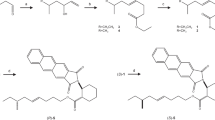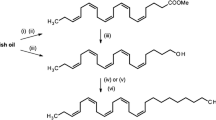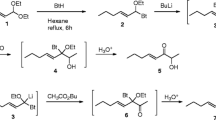Abstract
The two major components of the female sex pheromones of twoCreatonotos species have been identified as an achiral C21 triene, (Z,Z,Z)-3,6,9-heneicosatriene, and a chiral epoxide, (Z,Z)-2(2,5-octadienyl)-3-undecyloxirane. The ratios of these components in the two species fall into nonoverlapping ranges. Two additional achiral minor components, (Z,Z)-6,9-heneicosadiene and (Z,Z,Z)-3,6,9-tricosatriene, were also identified in the female sex gland extracts. The male pheromone of both species consists of hydroxydanaidal, a chiral dihydropyrrolizine derived from pyrrolizidine alkaloids in the larval diet.Creatonotos transiens was found to convert dietary heliotrine into (R)-(−)-hydroxydanaidal, with inversion at the single asymmetric carbon atom. The possible biological and biosynthetic significance of the chiral pheromone components are discussed, and they are compared with known examples of chiral lepidopteran pheromones.
Similar content being viewed by others
References
Attenburrow, J., Cameron, A.F.B., Chapman, J.H., Evans, R.M., Herns, B.A., Jansen, A.B.A., andWalker, T. 1952. A synthesis of vitamin A from cyclohexanone.J. Chem. Soc. 1952: 1094–1111.
Baker, R., andBradshaw, J.W.S. 1981. Insect pheromones and related behavior-modifying chemicals.Aliphatic Relat. Nat. Prod. Chem. 2:46–75.
Baker, R., andBradshaw, J.W.S. 1983. Insect pheromones and related natural products.Aliphatic Relat. Nat. Product Chem. 3:66–106.
Baker, R., andEvans, D.A., 1979. Insect pheromones are related behavior-modifying chemicalsAliphatic Relat.Nat. Prod. Chem. 1:102–127.
Baker, R., andHerbert, R.H. 1984. Insect pheromones and related natural products.Nat. Prod. Rep. 1:299–318.
Baker, T.C., Nishida, R., andRoelofs, W.L. 1981. Close-range attraction of female oriental fruit moths to herbal scent of male hairpencils.Science 214:1359–1360.
Bell, T.W., Boppŕe, M., Schneider, D., andMeinwald, J. 1984. Stereochemical course of pheromone biosynthesis in an artiid moth,Creatonotos transiens.Experientia 40:713–714.
Beroza, M., Bierl, B.A., Knipling, E.F., andTardif, J.G.R. 1971. The activity of the gypsy moth sex attractant disparlure vs. that of the live female moth.J. Econ. Entomol. 64:1527–1529.
Bierl, B.A., Beroza, M., andCollier, C.W. 1970. Potent sex attractant of the gypsy moth: Its isolation, identification, and synthesis.Science 170:87–89.
Bierl, B.A., Beroza, M., andCollier, C.W. 1972. Isolation, identification and synthesis of the gypsy moth sex attactant.J. Econ. Entomol. 65:659–664.
Bierl, B.A., Beroza, M., Adler, V.E., Kasang, G., Schroter, H., andSchneider, D. 1975. The presence of disparlure, the sex pheromone of the gypsy moth, in the female nun moth.Z. Naturforsch. 30C: 672–675.
Birch, M. 1974. Aphrodisiac pheromones in insects, pp. 115–134,in M.C. Birch (ed.). Pheromones. American Elsevier, New York.
Boppŕe, M. 1984. Chemically mediated interactions between butterflies, pp. 259–275,in R.I. Vane-Wright and P.R. Ackery (eds.). The Biology of Butterflies. Academic Press, London.
Connor, W.E., Eisner, T., Vander Meer, R.K., Guerrero, A., Ghiringelli, D., andMeinwald, J. 1980. Sex attractant of an arctiid moth (Utetheisa ornatrix): A pulsed chemical signal.Behav. Ecol. Sociobiol. 7:55–63.
Connor, W.E., Eisner, T., vander Meer, R.K., Guerrero, A., andMeinwald, J. 1981. Precopulatory sexual interaction in an arctiid moth (Utetheisa ornatrix): Role of a pheromone derived from dietary alkaloids.Behav. Ecol. Sociobiol. 9:277–235.
Culvenor, C.C.J., Edgar, I.A., Smith, L.W., andTweedale, H.J. 1970. Dihydropyrrolizidines. IV. Manganese dioxide oxidation of 1,2,-dehydropyrrolizidines.Aust. J. Chem. 23:1869–1879.
Culvenor, C.C.J., andEdgar, J.A. 1972. Dihydropyrrolizidine secretions associated with coremata ofUtetheisa moths (family Arctiidae).Experientia 23:627–628.
Edgar, J.A. 1975. Danainae (Lep.) and 1,2,-dehydropyrrolizidine alkaloid-containing plantswith reference to observations made in the New Hebrides.Phil. Trans. R. Soc. London Ser. B 272:467–476.
Edgar, J.A. 1982. Pyrrolizidine alkaloids sequestered by Solomon Island Danainae butterflies. The feeding preferences of the Danainae and Ithomiinae.J. Zool. 196:385–399.
Edgar, J.A., Culvenor, C.C.J., andPliske, T.E. 1976. Isolation of a lactone, structurally related to the esterifying acids of pyrrolizidine alkaloids, from the costal fringes of male Ithomiinae.J. Chem. Ecol. 3:263–270.
Einhorn, J., Lallemand, J.-Y., Zagatti, P., Gallois, M., Virelizier, H., Riom, J., andMenassieu, P. 1982. Isolement et identification de la phéromone sexuelle attractive deHyphantria cunea (Drury) (Lépidoptère, Arctiidae).C. R. Acad. Sci. Paris, Ser. C. 249:41–44.
Einhorn, J., Boniface, B., Renou, M., andMilat, M.-L. 1984. Etude de la phéromone sexuelle deArctia villica L. (Lépidoptère, Arctiidae).C. R. Acad. Sci. Paris, Ser. C. 298:573–576.
Francke, W., Mackenroth, W., Schroeder, W., Schulz, S., Tengoe, J., Engels, E., Engels, W., Kittmann, R., andSchneider, D., 1985. Identification of cyclic enolethers from insects: Alkyldihydropyranes from bees and alkyldihydro-4H-pyran-4-ones from a male moth.Z. Naturforsch. 40C: 145–147.
Grula, J.W., McChesney, J.D., andTaylor, O.R., Jr. 1980. Aphrodisiac pheromones of the sulfur butterfliesColias Eurytheme andC. philodice (Lepidoptera, Pieridae).J. Chem. Ecol. 6:241–256.
Hansen, K., 1984. Discrimination and production of disparlure enantiomers by the gypsy moth and nun moth.Physiol. Entomol. 9:9–18.
Hill, A.S., Anoroelofs, W.L. 1981. Sex pheromone of the saltmarsh caterpillar moth,Estigmene acrea.J. Chem. Ecol. 7:655–668.
Hill, A.S., Kovalev, B.G., Nikolaeva, L.N., andRoelofs, W.L. 1982. Sex pheromone of the fall webworm moth,Hyphantria cunea.J. Chem. Ecol. 8:383–396.
Jacobson, M., Beroza, M., andJones, W.A. 1960. Isolation, identification, and synthesis of the sex attractant of the gypsy moth.Science 132:1011–1012.
Jacobson, M., Beroza, M., andJones, W.A. 1961. Insect sex attractants. I. The isolation, identification, and synthesis of the sex attractant of the gypsy moth.J. Am. Chem. Soc. 83:4819–4824.
Jacobson, M., Green, N., Warthen, D., Harding, C., andToba, H.H. 1970. Sex pheromones of the lepidoptera, recent progress and structure-activity relationships, pp. 3–20,in M. Beroza (ed.). Chemicals Controlling Insect Behavior. Academic Press, New York.
Jain, S.C., Doussard, D.E., Connor, W.E., Eisner, T., Guerrero, andMeinwald, J. 1983. Polyene pheromone components from an arctiid moth (Utetheisa ornatrix): characterization and synthesis.J. Org. Chem. 48:2266–2270.
Kafka, W.A., Ohloff, G., Schneider, D., andVareschi, E. 1973. Olfactory discrimination of two enantiomers of 4-methylhexenoic acid by the migratory locust and honeybee.J. Comp. Physiol. 87:277–284.
Klun, J.A., Chapman, O.L., Mattes, K.C., Wojtkowski, P.W., Beroza, M., andSonnet, P.E. 1973. Insect sex pheromones: Minor amount of opposite geometrical isomer critical to attraction.Science 181:661–663.
Komae, H., Nishi, A., Tanaka, T., Hayashi, N., Wesou, C., andKuwahara, Y. 1982. Major components in the hairpencil secretions of danaid butterflies from far East Asia.Biochem. Syst. Ecol. 10:181–183.
Komae, H., Nishi, A., Hayashi, N., Wesou, C., andKuwahara, Y. 1983. Components of the sex brand secretions of some danaid butterflies.Agric. Biol. Chem. 47:157–158.
Kubo, I., Matsumoto, T., Wagner, D.L. andShoolery, J.N. 1985. Isolation and structure of hepialone: Principal component from male sex scales ofHepialus californicus (Lepidoptera).Tetrahedron Lett. 26:563–566.
Kunesch, G., Zagatti, P., Lallemand, J.Y., Debal, A., Vigneron, J.P. 1981. Structure and synthesis of the wing gland pheromone of the male African sugar-cane borer:Eldana saccharina (Wlk.) (Lepidoptera, Pyralidae).Tetrahedron Lett. 22:5271–5274.
Meyer, W. 1984. MS thesis, Cornell University.
Mori, K. 1984. The significance of chirality: Method for determining absolute configuration and optical purity of pheromones and related compounds, p. 323–370,in H.E. Hummel and T.A. Miller, (eds.). Techniques in Pheromone Research, Springer-Verlag, New York.
Mori, K., andEbata, T. 1981. Synthesis of optically active pheromones with an epoxy ring, (+)- disparlure and the saltmarsh caterpiller moth pheromone [(Z, Z)-3,6-cis-9,10-epoxyheneico-sadiene].Tetrahedron Lett. 43:4281–4282.
Myerson, J., Haddon, W.F., andSoderstrom, E.L. 1982.sec-Butyl (Z)-7-tetradecanoate. A novel sex pheromone component from the Western grapeleaf skeletonizer,Harrisina brillians.Tetrahedron Lett. 23:2757–2760.
Roelofs, W. 1979. Production and perception of lepidopterous pheromone blends, pp. 159–168, F.J. Ritter (ed.). Chemical Ecology: Odour Communication in Animals. Elsevier/North Holland Biomedical Press, New York.
Roelofs, W., andBjostad, L. 1984. Biosynthesis of lepidopteran pheromones.Bioorg. Chem. 12:279–298.
Roelofs, W., andCardé, R.T., 1974. Sex pheromones in the reproductive isolation of lepidopterous species, pp. 96–114,in M.C. Birch (ed.) Pheromones. American Elsevier, New York.
Roelofs W.L., Hill, A., andCardé, R. 1975. Sex pheromone components of the red-banded leafroller,Argyrotaenia velutinana (Lepodoptera: Tortricidae).J. Chem. Ecol. 1:83–89.
Schneider, D. 1984a. Pheromone biology in the Lepidoptera: Overview, some recent findings and some generalizations, pp. 301–313,in L. Bolis, R.D. Keynes, and S.H.P. Maddrell (eds.). Comparative Physiology of Sensory Systems. Cambridge University Press, London.
Schneider, D. 1984b. Insect olfaction-our research endeavor, pp. 381–418, W.W. Dawson and J.M., Enoch, (eds.). Foundations of Sensory Science. Springer-Verlag, New York.
Schneider, D., Boppŕe, M., Schneider, H., Thompson, W.R., Boriack, C.J., Petty, R.L., andMeinwald, J. 1975. A pheromone precursor and its uptake in maleDanaus butterflies.J. Comp. Physiol. 97:245–256.
Schneider, D., Boppŕe, M., Zweig, J., Horsley, S.B., Bell, T.W., Meinwald, J., Hansen, K., andDiehl, E.W. 1982. Scent organ development inCreatonotos moths: Regulation by pyrrolizidine alkaloids.Science 215:1264–1265.
Silverstein, R.M. 1979. Enantiomeric composition and bioactivity of chiral semiochemicals in insects, pp. 133–146,in F.J. Ritter (ed.). Chemical Ecology: Odour Communication in Animals. Elsevier/North Holland Biomedical Press, New York.
Silverstein, R.M. 1982. Chemical communication in insects: Background and application.Pure Appl. Chem. 54:2479–2488.
Sinnwell, V., Schulz, S., Francke, W., Kittmann, R., andSchneider, D. 1985. Identification of pheromones from the male swift mothHepialus hecta L.Tetrahedron Lett. 26:1707–1710.
Tamaki, Y. 1979. Multi-component sex pheromone of Lepidoptera with special reference toAdoxophyes sp., pp. 169–180,in F.J. Ritter (ed.). Chemical Ecology: Odour Communication in Animals. Elsevier/North Holland Biomedical Press, New York.
Tamaki, Y., Noguchi, H., Sugie, H., Sato, R., andKariya, A. 1979. Minor components of the female sex-attractant pheromone of the smaller tea tortrix moth (Lepidoptera: Tortricidae): Isolation and identification.Appl. Entomol. Zool. 14:101–113.
Tamaki, Y., Sugie, H., Osakabe, M., andSonnet, P. 1983. Biological activities of (R)- and (S)-10-methyldodecyl acetates, the chiral component of the sex pheromone of the smaller tea tortrix moth (Adoxophyes sp., Lepidoptera: Tortricidae).Appl. Entomol. Zool. 18:292–294.
Tamaki, Y., Noguchi, H., Horiike, M., andHirano, C. 1984. Biological activities of analogs of 10-methyldodecyl acetate, a sex-pheromonal component of the smaller tea tortrix moth (Adoxophyes sp., Lepidoptera: Tortricidae).Appl. Entomol. Zool. 19:245–251.
Tumlinson, J.H., Heath, R.R., andTeal, P.E.A. 1982. Analysis of chemical communications systems of Lepidoptera, pp. 1–25,in B.A. Leonhardt and M. Beroza (eds.). Insect Pheromone Technology: Chemistry and Applications. American Chemical Society, Washington, D.C.
Uchino, K., Yamagawa, Y., Kamikawa, T., andKubo, I. 1985. Synthesis of hepialone; principal component from male sex cells ofHepialus californicns (Lepidoptera).Tetrahedron Lett. 26:1319–1320.
Vigneron, J.P., Méric, R., Larcheveque, M., Debal, A., Kunesch, G., Zagatti, P., andGallois, M. 1982. Absolute configuration of eldanolide, the wing gland pheromone of the male African sugar cane borer,Eldana saccharina (Wlk.) Synthesis of its (+) and (−) enantiomers.Tetrahedron Lett. 23:5051–5054.
Vité, J.P., Klimetzek, D., Loskant, G., Hedden, R., andMori, K. 1976. Chirality of insect pheromones: Response interruption by inactive antipodes.Naturwissenschaften 63:582–583.
Wunderer, H.,Hansen, K.,Bell, T. W.,Schneider, D.,and Meinwald, J. 1986. Pheromones of males and females of two Asian moths (Creatonotos transiens, C. gangis; Lepidoptera: Arctiidae): Behavior, Morphology, Chemistry and Electrophysiology.Experimental Biology 45: Submitted.
Zaretskii, Z.V. 1976. Mass Spectrometry of Steroids. Wiley, New York.
Author information
Authors and Affiliations
Rights and permissions
About this article
Cite this article
Bell, T.W., Meinwald, J. Pheromones of two arctiid moths (Creatonotos transiens andC. gangis). J Chem Ecol 12, 385–409 (1986). https://doi.org/10.1007/BF01020563
Received:
Accepted:
Issue Date:
DOI: https://doi.org/10.1007/BF01020563




